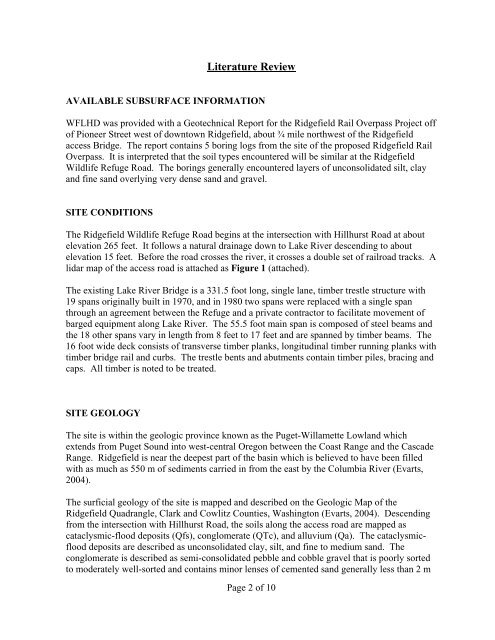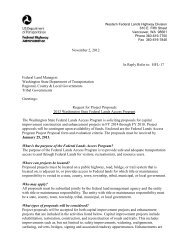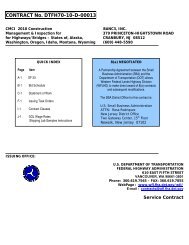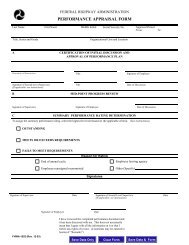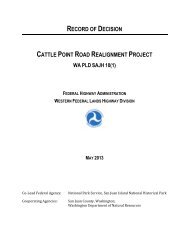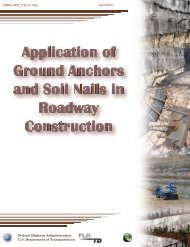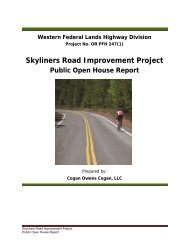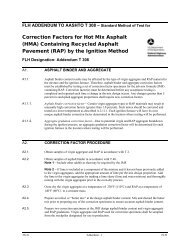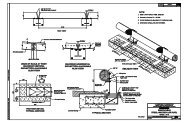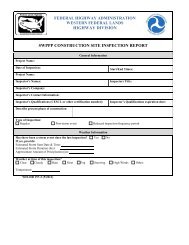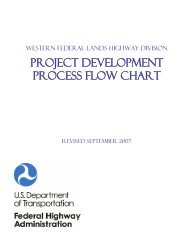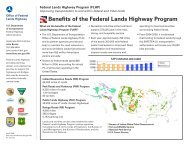Memorandum - Western Federal Lands Highway Division - U.S. ...
Memorandum - Western Federal Lands Highway Division - U.S. ...
Memorandum - Western Federal Lands Highway Division - U.S. ...
You also want an ePaper? Increase the reach of your titles
YUMPU automatically turns print PDFs into web optimized ePapers that Google loves.
Literature Review<br />
AVAILABLE SUBSURFACE INFORMATION<br />
WFLHD was provided with a Geotechnical Report for the Ridgefield Rail Overpass Project off<br />
of Pioneer Street west of downtown Ridgefield, about ¾ mile northwest of the Ridgefield<br />
access Bridge. The report contains 5 boring logs from the site of the proposed Ridgefield Rail<br />
Overpass. It is interpreted that the soil types encountered will be similar at the Ridgefield<br />
Wildlife Refuge Road. The borings generally encountered layers of unconsolidated silt, clay<br />
and fine sand overlying very dense sand and gravel.<br />
SITE CONDITIONS<br />
The Ridgefield Wildlife Refuge Road begins at the intersection with Hillhurst Road at about<br />
elevation 265 feet. It follows a natural drainage down to Lake River descending to about<br />
elevation 15 feet. Before the road crosses the river, it crosses a double set of railroad tracks. A<br />
lidar map of the access road is attached as Figure 1 (attached).<br />
The existing Lake River Bridge is a 331.5 foot long, single lane, timber trestle structure with<br />
19 spans originally built in 1970, and in 1980 two spans were replaced with a single span<br />
through an agreement between the Refuge and a private contractor to facilitate movement of<br />
barged equipment along Lake River. The 55.5 foot main span is composed of steel beams and<br />
the 18 other spans vary in length from 8 feet to 17 feet and are spanned by timber beams. The<br />
16 foot wide deck consists of transverse timber planks, longitudinal timber running planks with<br />
timber bridge rail and curbs. The trestle bents and abutments contain timber piles, bracing and<br />
caps. All timber is noted to be treated.<br />
SITE GEOLOGY<br />
The site is within the geologic province known as the Puget-Willamette Lowland which<br />
extends from Puget Sound into west-central Oregon between the Coast Range and the Cascade<br />
Range. Ridgefield is near the deepest part of the basin which is believed to have been filled<br />
with as much as 550 m of sediments carried in from the east by the Columbia River (Evarts,<br />
2004).<br />
The surficial geology of the site is mapped and described on the Geologic Map of the<br />
Ridgefield Quadrangle, Clark and Cowlitz Counties, Washington (Evarts, 2004). Descending<br />
from the intersection with Hillhurst Road, the soils along the access road are mapped as<br />
cataclysmic-flood deposits (Qfs), conglomerate (QTc), and alluvium (Qa). The cataclysmicflood<br />
deposits are described as unconsolidated clay, silt, and fine to medium sand. The<br />
conglomerate is described as semi-consolidated pebble and cobble gravel that is poorly sorted<br />
to moderately well-sorted and contains minor lenses of cemented sand generally less than 2 m<br />
Page 2 of 10


